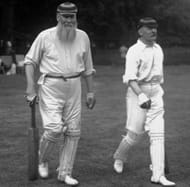
Arguably, the first great batsman in cricket's history, and undoubtedly, its first star, was WG Grace. He is credited with developing batting technique as we know it today.
KS Ranjitsinhji wrote in The Jubilee Book of Cricket (1897):
“He revolutionized batting. He founded the modern theory of batting by making forward and back play of equal importance, relying neither on one nor the other, but both. He turned the old one-stringed instrument into a many chorded lyre.”
The emergence of WG Grace saw significant developments in the game. In 1864, over-arm bowling was approved. Grace was then able to develop a batting technique that countered this revolutionary over-the-shoulder style of delivering the ball. County cricket began the same year, as was Wisden first published.
The popular image of Dr. William Gilbert Grace is that of the Grand Old Man, portly, ageing, with a flowing grey beard. But his best came very early on in his career.
It is reckoned that he was at 18 years of age, the best batsman in England, and the world. That was in 1866. Playing for an England XI against Surrey, Grace scored 224 not out in a crushing victory of an innings and 300 runs.
Vic Marks wrote about that performance:
“On the last afternoon, his captain gave him permission to pop off to Crystal Palace to run in a 440-yard hurdle race - he won. Three weeks later, he scored 173* for the Gentlemen of the South against Players of the South at The Oval, having already taken seven wickets whilst bowling unchanged throughout the Players’ innings.”
WG Grace's best days were in the pre-Test cricket era
Grace’s halcyon days were before the advent of Test cricket. Peter Hartland reflected:
“Picture him in 1873, as a 25-year-old, already known for prodigious feats in track and field athletics. At this stage, he scored more runs - over 10,000 - than anyone else in history to date, at more than double the average. His career average was now 61, the next best being (reputedly the best professional batsman of the 1860s and 1870s) Richard Daft’s 29."
Hartland continued:
“Grace was literally twice as good as anyone who had ever played. The remarkable thing to remember about Grace is not so much his cricketing longevity, but the fact that he established a lead over his contemporaries which has never been equalled.”
It must be remembered that WG Grace had to play on pitches in the 1860s that were terrible for batting. Hartland elucidated,
“….. pitches, still rough and ready with scant regard for evenness or slope, had barely improved. The only tool in regular use was the scythe, complementing the work of rabbits, sheep and, on one reported occasion at Lord’s, a brace of partridges.”
Batting was a hazardous exercise as WG Grace’s own observation on wickets bears out:
“Many of the principal grounds were positively dangerous to play upon and batsmen were commonly damaged by the fast bowling. The batsmen had to look out for shooters and leave the bumping balls to look after themselves. In the 60s, it was no unusual thing to have three shooters in an over.”
And there were only four deliveries in an over in those days!

Later, the tracks did improve somewhat. It is no coincidence that in 1871, around the time the heavy roller came to be used, WG Grace became the first batsman to score 2000 runs in a season. He managed 2,739 runs at an average of 78.25 with 10 hundreds, including two double centuries.
WG Grace dominated the prestigious Gentlemen vs Players fixtures
That was an age when there was a clear demarcation between the amateurs and the professionals, or the Gentlemen and the Players. The Gentlemen were the aristocrats of the game and invariably batsmen, while much of the hard labour, mainly bowling, fell to the lot of the Players.
Most of the time, it were the Players who triumphed but as Marks recorded,
“Only during the Grace era did the Gentlemen dominate the fixture. WG seemed to save his best performance for the occasion, which serves to emphasize the fact that it was the most important game in the cricket calendar.”
WG Grace also bowled accurate medium-paced to slow leg-cutters and became the first to accomplish the double of 1000 runs and 100 wickets in a season, in 1873.
WG Grace was stupendous in The Gentlemen vs The Players match at Lord’s in 1876. Opening the batting, he scored 169 out of the team’s total of 449. He then bowled 97 four-ball overs, taking three for 81 and six for 41 as The Players collapsed for 219 and 132 in their two innings.
That year, he became the first batsman to score a triple century in first-class cricket. As if to celebrate, he hit another, two innings later. His sequence of scores were 344, 177, and 318*, and, in the month of August, he piled up another 1,279 runs.
The 1870s were a golden period for Gloucestershire in the County Championships. WG Grace and his brothers, Edward Mills and George Frederick, with a team composed entirely of amateurs, won the title for Gloucestershire, jointly with Nottinghamshire in 1873, and then on their own in 1874, 1876, and 1877, and never thereafter.
(Excerpt from Indra Vikram Singh's book 'Don's Century').
Follow IPL Auction 2025 Live Updates, News & Biddings at Sportskeeda. Get the fastest updates on Mega-Auction and cricket news
